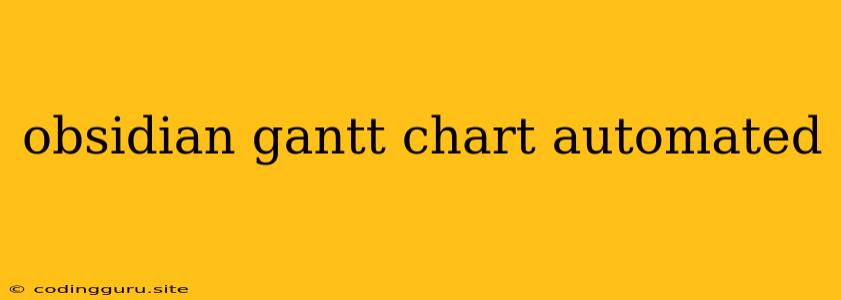Planning Your Projects Like a Pro: Obsidian Gantt Charts and Automation
Obsidian is a powerful note-taking application that's rapidly gaining popularity for its versatility and features. Among its many strengths is the ability to create Gantt charts for project management. While manual creation of these charts can be helpful, Obsidian Gantt charts can be significantly enhanced with automation, allowing you to streamline your workflow and focus on the big picture.
Why Use Gantt Charts?
Gantt charts are visual representations of tasks and their dependencies over a period of time. They provide a clear overview of a project's timeline, making it easier to:
- Track progress: Visualize the completion status of each task.
- Identify dependencies: Understand how tasks relate to each other and prevent delays.
- Manage resources: Allocate resources effectively based on task deadlines.
- Communicate clearly: Share project plans and progress with team members.
Automating Your Obsidian Gantt Charts
Obsidian, on its own, doesn't have built-in automation for Gantt charts. However, there are several plugins and techniques you can utilize to achieve this:
1. The Dataview Plugin:
This versatile plugin allows you to create Gantt charts dynamically based on data stored in your notes. By structuring your notes appropriately, you can use Dataview queries to populate your Gantt chart with relevant information:
- Task Name: The title of the task.
- Start Date: The date the task begins.
- Due Date: The date the task is expected to be completed.
- Duration: The estimated time to complete the task.
- Dependencies: Any tasks that need to be completed before this task can start.
2. The Calendar Plugin:
This plugin allows you to create calendar views within Obsidian. By linking tasks to specific dates, you can automatically generate a visual representation of your project timeline:
- Task Notes: Include the task details and its corresponding dates.
- Calendar View: The calendar view will automatically display your tasks based on the dates you've specified.
3. Using the Dataview Plugin for Automated Updates:
The real power of automation comes from using Dataview to update your Gantt charts automatically as you progress through your project.
- Task Completion: Mark completed tasks in your notes, and Dataview can update the Gantt chart to reflect their completion status.
- Date Adjustments: If deadlines change, simply modify the dates in your notes, and Dataview will dynamically update the Gantt chart accordingly.
4. Using the Templater Plugin:
The Templater plugin allows you to create reusable templates that can be used to generate new notes. You can create templates that automatically include the necessary fields for creating Gantt charts with the Dataview plugin.
Tips for Effective Automated Gantt Charts in Obsidian
- Consistent Note Structure: Maintain a standardized format for your task notes to ensure consistent data input for your Gantt charts.
- Clear Dependencies: Define dependencies between tasks clearly to prevent misinterpretations.
- Regular Updates: Regularly update task completion status and deadlines to maintain accuracy.
- Experiment: Explore different plugin combinations and query approaches to find the best fit for your project management style.
Benefits of Automating Your Obsidian Gantt Charts
- Increased Efficiency: Reduce time spent manually updating your charts.
- Improved Accuracy: Maintain consistent and up-to-date information.
- Better Visualization: Easily track progress and identify potential bottlenecks.
- Enhanced Collaboration: Share automated Gantt charts with team members for improved transparency.
Conclusion
By incorporating automation into your Obsidian Gantt charts, you can elevate your project management capabilities. Leveraging plugins like Dataview and Templater enables you to streamline your workflow, improve accuracy, and gain valuable insights into your project's progress. As you explore the possibilities, remember to experiment and adapt your approach to find the best solution for your specific needs.
